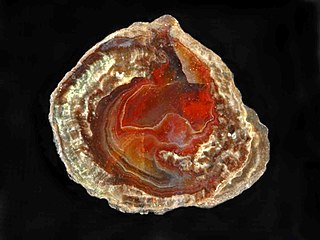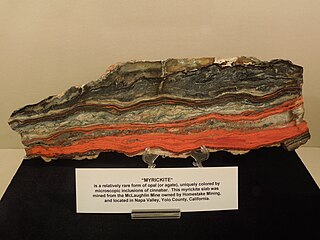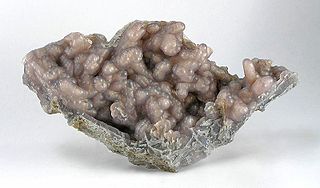
Chert is a hard, fine-grained sedimentary rock composed of crystals of quartz (silica) that are very small (microcrystalline or cryptocrystalline). Quartz (silica) is the mineral form of silicon dioxide (SiO2). Chert is often of biological origin (organic) but may also occur inorganically as a chemical precipitate or a diagenetic replacement (e.g., petrified wood). Geologists use chert as a generic name for any type of microcrystalline or cryptocrystalline quartz.

Onyx primarily refers to the parallel banded variety of the silicate mineral chalcedony. Agate and onyx are both varieties of layered chalcedony that differ only in the form of the bands: agate has curved bands and onyx has parallel bands. The colors of its bands range from white to almost every color. Commonly, specimens of onyx contain bands of black and/or white. Onyx, as a descriptive term, has also been applied to parallel banded varieties of alabaster, marble, obsidian and opal, and misleadingly to materials with contorted banding, such as "Cave Onyx" and "Mexican Onyx".

A thunderegg is a nodule-like rock, similar to a filled geode, that is formed within rhyolitic volcanic ash layers. Thundereggs are rough spheres, most about the size of a baseball—though they can range from less than an inch to over a meter across. They usually contain centres of chalcedony which may have been fractured followed by deposition of agate, jasper or opal, either uniquely or in combination. Also frequently encountered are quartz and gypsum crystals, as well as various other mineral growths and inclusions. Thundereggs usually look like ordinary rocks on the outside, but slicing them in half and polishing them may reveal intricate patterns and colours. A characteristic feature of thundereggs is that the individual beds they come from can vary in appearance, though they can maintain a certain specific identity within them.

Dzi bead is a type of stone bead of uncertain origin worn as part of a necklace and sometimes as a bracelet. In several Asian cultures, including that of Tibet, the bead is considered to provide positive spiritual benefit. These beads are generally prized as protective amulets and are sometimes ground into a powder to be used in traditional Tibetan medicine. Beads subject to this process have small "dig marks" where a portion of the bead has been scraped or ground away to be included in the medicine. Some dzi exhibit grinding and polishing of one or both ends, again the result of reduction for use in traditional Tibetan medicine or, in some cases, due to the bead's use as a burnishing tool in the application of gold leaf to thanka paintings or gilt bronze statuary.

A lithophysa is a felsic volcanic rock with a small spherulitic cavity and concentric chambers. Its shape is spherical or lenticular. These rocks are usually found within obsidian or rhyolite.

Fire agate, a variety of chalcedony, is a semi-precious natural gemstone discovered so far only in certain areas of central and northern Mexico and the southwestern United States. Approximately 24-36 million years ago these areas were subjected to massive volcanic activity during the Tertiary Period. The fire agates were formed during this period of volcanism when hot water, saturated with silica and iron oxide, repeatedly filled cracks and bubbles in the surrounding rock.
An agate (US) or ruby (UK) is a unit of typographical measure. It is 5.5 typographical points, or about 1⁄14 inch. It can refer to either the height of a line of type or to a font that is 5.5 points. An agate font is commonly used to display statistical data or legal notices in newspapers. It is considered to be the smallest point size that can be printed on newsprint and remain legible.
Brahmagiri is an archaeological site located in the Chitradurga district of the state of Karnataka, India. Legend has it that this is the site where sage Gautama Maharishi and his wife Ahalya lived. He was one among seven noted Hindu saints. This site was first explored by Benjamin L. Rice in 1891, who discovered rock edicts of Emperor Ashoka here. These rock edicts indicated that the locality was termed as Isila and denoted the southernmost extent of the Mauryan empire. The Brahmagiri site is a granite outcrop elevated about 180 m. above the surrounding plains and measures around 500 m east-west and 100 m north-south. It is well known for the large number of megalithic monuments that have been found here. The earliest settlement found here has been dated to at least the 2nd millennium BC.

The Sheldon National Wildlife Refuge is a 573,504-acre (232,089 ha) national wildlife refuge on the northern border of the U.S. state of Nevada. A very small part extends northward into Oregon. It is managed by the United States Fish and Wildlife Service (USFWS) as the Nevada component of the Sheldon-Hart Mountain National Wildlife Refuge Complex, which is headquartered in Lakeview, Oregon. The Sheldon Refuge is noted for its population of wild horses, now all removed and The Virgin Valley Mining District for Black Precious Opals,the State Gemstone, still very active with multiple fee dig mines. A point within the refuge is also the farthest place in the continuous US from a McDonald's restaurant, at just 115 miles.

Myrickite is a name used for both the agatized and opalized cinnabar materials. With a Mohs hardness of 7, the agatized form is a red-orange with bits of white, whereas the opalized material is orange and black and is 5 on the Mohs hardness scale. Although similar in color, this material should not be confused with the stone from China referred to as "Chicken Blood", as that material is a cinnabar stained serpentine with a hardness of 2.5-4. Unique to the United States, Myrickite is found at only one location in any quantity. During the early 1950s, Myrickite had been found in small quantities at the Manhattan Mine, located in Napa County, California, USA.

Agate Beach State Recreation Site is a state park between Newport and Agate Beach in Lincoln County in the U.S. state of Oregon. It is administered by the Oregon Parks and Recreation Department.

Adularescence is an optical phenomenon, similar to labradorescence and aventurescence, that is produced in gemstones such as moonstones.
Foil opals are simulated opal gemstones that first came into vogue during the jewelry-making boom of the late-Victorian era. Across Europe and the United States, these faux gemstones joined their paste counterparts as the need for jewelry outstripped both gemstone availability and nouveau middle-class budgets. The term 'foil' refers to an actual metal foil that was sometimes used to create reflection and sparkle behind milky glass or quartz faces. Though technically incorrect, other simulated opals with various types of sparkling inclusions or shiny backings are sometimes also referred to as 'foil opals' by jewelry collectors.
Pearlie is a 2009 Australian/Canadian animated comedy series based on the children's book series Pearlie the Park Fairy by Wendy Harmer. Pearlie is a co-production between Australian children's television producer Sticky Pictures and Canadian animation house Nelvana. The series aired on Network Ten in Australia, YTV in Canada, Pop Girl in the United Kingdom, and airs reruns on Qubo in the United States. Australian media distributor Madman Entertainment released five DVDs of Pearlie in 2010.

Shaw Springs is a privately owned unincorporated settlement in British Columbia's Thompson Canyon.

Cumborah is a town in north-western New South Wales, Australia. The town is in the Walgett Shire local government area, near the opal fields of Lightning Ridge. Cumborah is about 36 kilometres (22 mi) of the Castlereagh Highway and is served by the commercial centres of Lightning Ridge and Walgett, 48 kilometres (30 mi) to the south-east.
Jeffery Stanford "Jeff" Agate, OBE was the Managing Director of the DuPont factory at Maydown, County Londonderry, Northern Ireland. He was shot dead by members of the Provisional Irish Republican Army (IRA) outside his home at Talbot Park, Derry as he returned from work on the evening of February 2, 1977.















